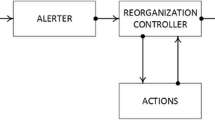Abstract
The rapid growth of data volumes which store the increasing amount of information makes the necessity of searching for the effective methods of data storing and processing. Some researches on this field recommend changing the row data organization that is classical for DBMS to the columnar one and/or the in-memory approach usage. The article presents chosen hybrid solutions which simultaneously enable storing data both in a row-based way and column-based one, as well as process these data in the in-memory technology.
Access this chapter
Tax calculation will be finalised at checkout
Purchases are for personal use only
Similar content being viewed by others
Notes
- 1.
Queries included operators: ROLLUP, CUBE, GROUPING SETS, aggregate functions: COUNT, AVG, SUM, ranking functions: RANK, DENSE_RANK and PARTITION BY clause.
- 2.
For a better visualization the differences in speed of query execution in Actian Vectorwise, Infobright, Sybase IQ and MS SQL Server 2012 database systems, the percentage scale on Y axis was used.
- 3.
The INMEMORY_SIZE initialization parameter specifies the amount of memory reserved for use by the IM column store. The larger the in-memory area, the greater the number of database objects that can utilize it.
- 4.
CRITICAL \(>\) HIGH \(>\) MEDIUM \(>\) LOW.
- 5.
The data stored in the in-memory column format is automatically compressed with a set of compression techniques that improve the memory capacity, the query performance or both elements.
- 6.
All row groups were compressed.
- 7.
INMEMORY MEMCOMPRESS FOR QUERY (MFQ), MEMCOMPRESS FOR CAPACITY (MFC), MEMCOMPRESS FOR DML (MFDML) and MEMCOMPRESS FOR QUERY HIGH (MFQH).
References
Abadi, D.: A tour through hybrid column/row-oriented DBMS schemes (2014). http://dbmsmusings.blogspot.com/2009/09/tour-through-hybrid-columnrow-oriented.html
Abadi, D., Madden, S., Hachem, N.: Columnstores versus rowstores: how different are they really? In: ACM SIGMOD/PODS. Vancouver (2008)
Bach, M., Werner, A.: Analiza zasadności stosowania kolumnowej organizacji danych dla celów przetwarzania analitycznego. In: Internet in the Information Society, pp. 5–18 (2014)
Bach, M., Werner, A., Duszeńko, A.: Dobór struktur danych pod ka̧tem optymalizacji przetwarzania analitycznego. Studia Informatica 33, 145–156 (2012)
Bach, M., Werner, A., Duszeńko, A.: Ocena efektywności stosowania indeksów kolumnowych w bazach danych. Studia Informatica 33, 129–144 (2012)
Bajaj, P., Dhindsa, S.K.: A comparative study of database systems. Int. J. Eng. Innov. Technol. 1, 267–269 (2012)
Chen, W.J., Bläser, B., Bonezzi, M., Lau, P., Pacanaro, C., Schlegel, M., Zaka, A., Zietlow, A.: Architecting and deploying DB2 with BLU acceleration. In: IBM International Technical Support Organization (2014)
Jindal, A.: The mimicking octopus: towards a one-size-fits-all database architecture. In: VLDB Ph.D. Workshop, pp. 78–83. Singapore (2010)
Marx, D.: Oracle database in-memory option. In: Sangam14. Bangalore (2014). http://www.aioug.org/sangam14/images/Sangam14/Presentations/DB-In-Mem-Workshop.pdf
Microsoft: Columnstore Indexes Described. http://msdn.microsoft.com/en-us/library/gg492088.aspx
Microsoft: Using Clustered Columnstore Indexes. http://msdn.microsoft.com/en-us/library/dn589807.aspx
Oracle: Oracle Database In-Memory, Powering the Real-Time Enterprise. http://www.oracle.com/technetwork/database/options/database-in-memory-ds-2210927.pdf
Oracle: Oracle Help Center: Database Administrator’s Guide. https://docs.oracle.com/database/121/ADMIN/memory.htm#ADMIN14239
Plattner, H.: A common database approach for OLTP and OLAP using an in-memory column database. In: ACM SIGMOD/PODS, pp. 1–2. Providence (2009)
Plattner, H.: Column-Oriented Databases, an Alternative for Analytical Environment (2010)
Potasiński, P.: SQL Server 2014–STATISTICS IO a klastrowane indeksy kolumnowe. http://blog.sqlgeek.pl/category/sql-server-2014
Sheldon, R.: SQL Server 2014 columnstore index: the good, the bad and the clustered (2014). http://searchsqlserver.techtarget.com/feature/SQL-Server-2014-columnstore-index-the-good-the-bad-and-the-clustered
Stonebraker, M., Cetintemel, U.: “One size fits all”: an idea whose time has come and gone. In: ICDE, pp. 2–11. Tokyo (2005)
Author information
Authors and Affiliations
Corresponding author
Editor information
Editors and Affiliations
Rights and permissions
Copyright information
© 2016 Springer International Publishing Switzerland
About this paper
Cite this paper
Bach, M., Werner, A. (2016). Hybrid Column/Row-Oriented DBMS. In: Gruca, A., Brachman, A., Kozielski, S., Czachórski, T. (eds) Man–Machine Interactions 4. Advances in Intelligent Systems and Computing, vol 391. Springer, Cham. https://doi.org/10.1007/978-3-319-23437-3_60
Download citation
DOI: https://doi.org/10.1007/978-3-319-23437-3_60
Published:
Publisher Name: Springer, Cham
Print ISBN: 978-3-319-23436-6
Online ISBN: 978-3-319-23437-3
eBook Packages: EngineeringEngineering (R0)




